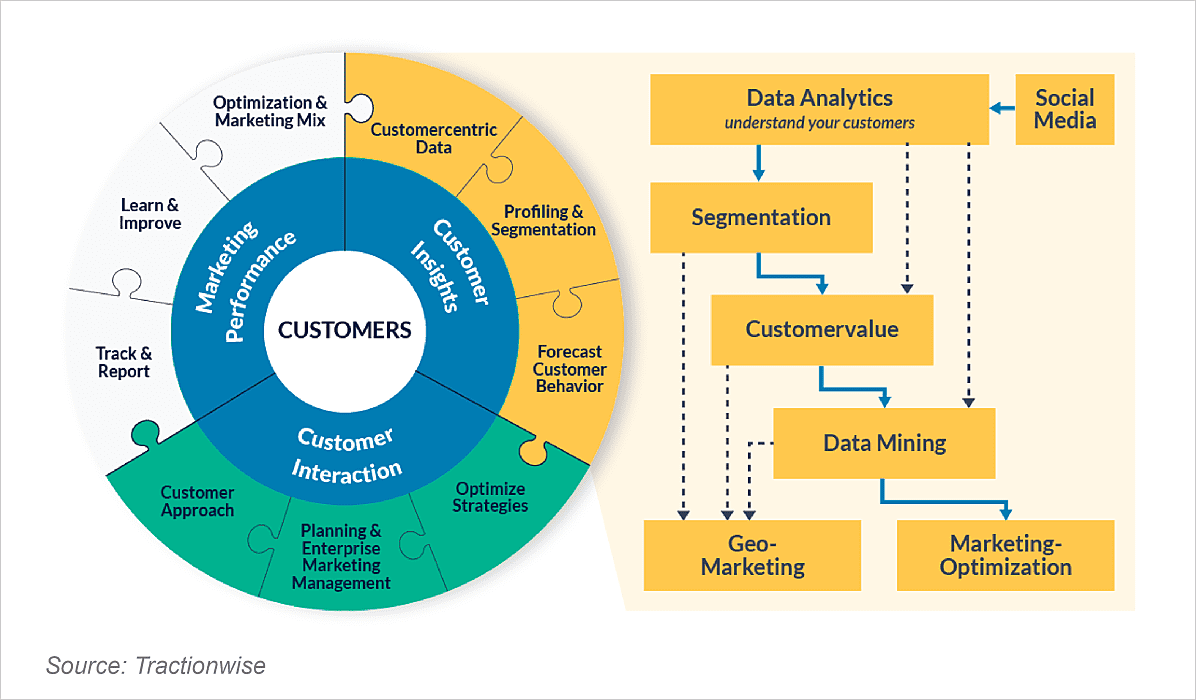
- How can you categorize different technology trends?
- Understanding the different types of technology trends
-
Trends Transforming Tomorrow: Key Technologies for 2024
- 1. AI Integration Everywhere
- The Interplay of Physical and Digital Realm
- Greener Technologies
- Computing Power
- Digital Twins
- Bridging the gap to next-generation technology with Quantum Computing
- Web 3.0- Understanding Beyond the Hype and Reality
- The Rise of Humanoid Robots in 2024
- 5G Technology - The Rise and Future Advancements
- The Ascendence of Self-DrivingTechnology
- Edge computing - Bridging the Gap Between Data Storage and Computation
- Democratization - A Democracy in Technology
- Human Augmentation - Enhancing Cognitive Abilities
- Distributed Cloud - Connecting Operations to Cloud Services
- DARQ - An Asset for Hiring and Training
- Maximizing Tech Utilization with Personal Profiling
- The Introduction of 6G
- Data-Driven Policing - Countering Data Breaches and Cyber-Attacks
- Momentary Markets - For the Transformation of Customer Analytics and Advertising
- Automation - For Advancements in Analytics
- Reskilling - Upscaling Human's Digital Sophistication
- Medical Upgrade - The Rise of 3D Printing
- Digital Debit - Growth in Adoption of Digital Transactions
- Charting the Course Ahead: Key Takeaways from 2024’s Emerging Tech Trends
- Final Words

The rapid developments in technology continue to shape our daily lives and global economy. Each year brings a new technological development that once seemed the stuff of science fiction. The latest technology trends have witnessed development in artificial intelligence, breakthroughs in quantum computing, biotechnology, and more.
This article explores the top technology trends in 2024, offering a glimpse into what the future for tech and innovation looks like. Whether you are a tech enthusiast or a business leader, understanding these trends is important to stay ahead. Read on to discover which technologies are set to dominate the year 2024.
How can you categorize different technology trends?
Technology trends can be categorized based on several parameters. This categorization is primarily based on the context and perspective. Let’s understand some common categorizations for future technology trends.
1. Industry Verticals
Technology trends can be grouped according to the industries they predominantly affect. This can include healthcare, finance, education, automobile, agriculture, and entertainment.
2. Technology Domains
Emerging technology trends can be grouped by the type of technology involved. This can include artificial intelligence, blockchain, Internet of Things, augmented reality, virtual reality, robotics, biotechnology, renewable energy, and nanotechnology.
3. Development Stages
Trends un technology can be categorized based on their development stages. This includes emerging technologies, e.g., quantum computing, maturing technologies like 3D printing, and established technologies like smartphones and the internet.
4. Impact Areas
Top technology trends can be classified based on the areas they impact. These areas can include productivity enhancement, cost reduction, sustainability, healthcare improvement, accessibility, security, and entertainment.
5. Geographical Regions
Trends in technology can be categorized based on their prominence in different geographical regions or markets. This is done by considering factors like adoption rates, regulatory environments, and cultural preferences.
6. Time Horizons
Top technology trends can be classified based on their expected time horizons for widespread adoption. For instance, short-term trends (1-3 years), mid-term trends (3-5 years), and long-term trends (5+ years).
Understanding the different types of technology trends
Before moving ahead with the latest technology trends in 2024, lets understand briefly the types of technology trends.
1. Emerging Technology Trends
These are new and cutting-edge technologies that are in the early stages of development and adoption. Examples of some new technology trends include quantum computing, synthetic biology, and brain-computer interfaces.
2. Healthcare Technology Trends
Advancements in healthcare technologies aim to improve patient care, diagnostics, treatment outcomes, and healthcare delivery. Examples include telemedicine, precision medicine, medical robotics, and health informatics.
3. Sustainable Trends in Technology
These are technologies designed to address environmental challenges and promote sustainability. For instance, renewable energy systems, energy-efficient technologies, and green transportation solutions.
4. Retail Technology Trends
Retail technology trends encompass innovations and advancements specifically tailored to the retail industry, aiming to enhance customer experiences, streamline operations, and drive business growth. This can include Omnichannel retailing, contactless payments cashless stores, and more.
5. Supply Chain Technology Trends
Supply chain technology trends are driven by innovations and developments in supply chain process management, optimization, and automation. This includes the use of blockchain technology to improve transparency and traceability, Internet of Things (IoT) devices to track and monitor inventory and assets in real-time, and more.
6. Marketing Technology Trends
Marketing technology trends include developments and advancements in tools and platforms that help marketers reach and engage their target customers more effectively.
This includes using data analytics and artificial intelligence for customer segmentation, personalization, and targeted advertising. Other examples include using marketing automation software to streamline marketing workflows and campaign management.
7. Human Resource Technology Trends
Human resource technology trends are focused on developments in HR software and technologies that assist firms in managing their workforce more efficiently and effectively. This includes the use of cloud-based HR management systems for centralized employee data management, talent acquisition platforms for recruitment and candidate screening, and more.
Trends Transforming Tomorrow: Key Technologies for 2024
Let's have a detailed look at the top trends in technology that are expected to shape the future of different industries.
1. AI Integration Everywhere
AI integration in various tactical business operations has already become one of the latest technology trends. From sales & marketing to customer support, AI is everywhere. With advanced solutions like Chat-GPT, artificial intelligence is creating revolutions everywhere.
As per Statista, more than 200 million people used AI tools in 2023. This number is expected grow to 700 million by the end of this decade. Integrating AI can simplify and streamline business processes. Here’s how artificial intelligence can transform businesses and departments.
| Artificial Intelligence in Sales |
|
| Artificial Intelligence in Marketing |
|
| Artificial Intelligence for Customer Support |
|
| Artificial Intelligence in Business Operations |
|
2. The Interplay of Physical and Digital Realm
With the introduction of technologies such as augmented reality, virtual reality, metaverse, etc, the gaps between the digital and physical realms are rapidly converging. The top technology trends are bridging the gap between the tangible world and the digital sphere. It is one of the emerging technology trends that is used in developing smart cities, supporting digital health monitoring, developing connected retail stores, and more.
The interplay between the physical and digital world powered by current technology trends is reshaping industries, and transforming how we live, work, and interact. As these trends continue to grow, we can expect enhanced collaboration between digital and physical environments. This can unlock new possibilities and drive innovation forward. Let’s understand how this collaboration can impact business and its processes.
| Supply Chain Management |
|
| Manufacturing Processes |
|
| Customer Engagement |
|
3. Greener Technologies

Greener technologies refer to innovations that are environmentally friendly. These solutions are primarily aimed at reducing pollution, conserving natural resources, and minimizing waste. These technologies support sustainable development and mitigate the impact of human activities on the environment. The key types of greener technologies include the following-
| Renewable energy technologies | They help reduce dependence on fossil fuels. For instance Solar, wind, hydro, and geothermal energy |
| Electric and hybrid vehicles | These vehicles use electric motors instead of combustion engines. These reduce greenhouse gas emissions and air pollution. |
| Waste management technologies | These primarily include composting, recycling, and waste-to-energy technologies. |
| Sustainable building materials | These include innovations like greener insulation materials, bamboo, recycled flooring, and low VOC. |
4. Computing Power
The advancements in computing power continue to be among the significant technology trends that benefit businesses across different sectors. With the development in computing power, businesses can easily process and analyze large volumes of data. Additionally, it supports more robust cloud services for businesses.
Industries such as manufacturing, pharmaceuticals, and aerospace can benefit from advanced computing power. The increasing computing power is enabling businesses to innovate faster, operate more efficiently, and improve the overall customer experience.
5. Digital Twins
A digital twin is a detailed virtual model that mirrors a physical object, system, or process. This idea is particularly beneficial for different fields like urban planning, manufacturing, healthcare, and more. Digital twins use sensor data from physical items to replicate real-world dynamics. The constant data flow between the real and the virtual world supports real-time monitoring, analysis, and simulation.
Let’s understand how Digital Twins, one of the current technology trends, is revolutionizing the manufacturing industry.
| Predictive Maintenance | Digital Twins enable manufacturers to accurately forecast the wear and tear of the machinery over time. This allows them to schedule maintenance only when necessary. |
| Real-time monitoring | Digital Twins allow for real-time monitoring and control by creating virtual replicas of the physical equipment. |
| Improved product design and development | With digital twins, manufacturers can try and test the prototypes in a virtual environment before making the physical products. |
| Sustainability and environmental compliances | Digital Twins promotes more environmentally friendly manufacturing methods. These provide complete control over resource optimization and production methods. |
6. Bridging the gap to next-generation technology with Quantum Computing
Quantum computing is among the current technology trends widespread throughout the globe. With so much data at bay collected by companies, it is simply impossible for a regular processor to create models that are efficient enough to solve complex problems using regular computational power. For example, calculation of the largest prime number for creating encryptions.
In quantum computing, remarkable advancements in computational power have been achieved over the years. This marks significant leaps forward in this technology. This one of the sensations among the top technology trends works at the subatomic level. It is aimed to create processors that are trillion times faster than the current generation of regular processors. With the capability of quantum computing, humans would be able to solve multiple equations that will help unfold and discover various realities that would otherwise take years to achieve. Let’s explore how this technology has the potential to transform industries.
| Finance Industry |
|
| Manufacturing Industry |
|
| Healthcare Industry |
|
| Transportation |
|
7. Web 3.0- Understanding Beyond the Hype and Reality
Web 3.0 or Web3 is the third generation of the World Wide Web. It is specifically developed to be decentralized or open to anyone and everyone. It is based on advanced technical parameters and values that distinguish it from the earlier iterations of the World Wide Web.
Web3 offers individual control of personal data, cryptocurrencies, and decentralized record-keeping on the blockchain. Here’s how Web3 can help businesses and different industries.
| Finance and Banking | Web3 technologies like Blockchain can significantly improve security and transparency in financial transactions. |
| Healthcare Industry | Web 3.0 facilitates the secure sharing of all healthcare data. This ensures improved patient care and medical outcomes. |
| Supply Chain and Logistics | Distributed ledgers and IoT devices enable real-time tracking and traceability across different supply chains. This reduces delays and improves trust among the stakeholders. |
| Manufacturing | With the use of AI, IoT sensors, and Blockchain, Web3 can optimize the manufacturing process. Real-time data can support quality control and predictive maintenance that leads to cost savings. |
| Energy and Utilities | Web3 can optimize energy grids and resource management through decentralized energy trading platforms. |
8. The Rise of Humanoid Robots in 2024
Humanoids are artificially designed machines or robots that can perform and replicate tasks similar to humans. These robots primarily look like humans, with a similar body structure. The machines are equipped with artificial intelligence, sensors, and actuators. These features allow humanoids to perceive their environments, interact with humans, and execute given tasks.
While humanoids hold great potential for automating and simplifying day-to-day tasks, their development raises ethical and social concerns. As technology advances, humanoids are expected to become more sophisticated, versatile, and more accessible in their daily lives. Let’s understand how humanoids can transform different industries.
| Research and Development | Humanoids offer a great platform for studying human-robot interaction in the simplest manner possible. |
| Education | Humanoids can be used by educational institutions to teach robotics, programming, and STEM. |
| Healthcare | Humanoids are a great innovation for the healthcare industry. These automated machines can be used to monitor patients. Humanoids can also be used for therapy and rehabilitation. |
| Customer Service and Therapy | Humanoids can be employed in retail stores, hotels, airports, etc. to greet customers, provide information, and perform other similar tasks. |
9. 5G Technology - The Rise and Future Advancements
The future of 5G technology guarantees high internet speed and smooth operations online for all users across the globe. The term ‘5G’, one of the fastest rising latest technology trends, has been creating a buzz for almost half a decade now. The advent of 5G is one of the most enigmatic existing technologies that will impact businesses in 2024. Many industry experts of upcoming IT technologies have termed 5G as the future of communication.
The technology is being rapidly adopted across different countries and regions. As per Statista, North America is expected to have the highest adoption rate by 2030, followed by China.
5G networks leverage various technologies to realize their performance goals. These can include millimeter waves, small cells, software-defined networking, and more. These technologies enable smoother and faster data transmission, increased network capacity, and improved reliability. Let’s have a look at how this technology can supercharge the working of businesses in different industries.
| Retail Industry |
|
| Finance Industry |
|
| Energy |
|
| Telecommunications |
|
10. The Ascendence of Self-DrivingTechnology
Automotive companies like Tesla, Alphabet, and Waymo have leveraged the latest trends in technology to offer a unique experience for their customers. The increasing adoption of this technology also signifies the upward trajectory and increasing prominence of the autonomous driving systems.
The idea of a driverless car in itself generates a considerable amount of excitement. However, an idea that seemed almost impossible to achieve has stemmed its footing. Now, there are multiple companies worldwide with the vision of driverless cars.
There is still time for the modulation of the laws for emerging technology trends like autonomous driving by legislators, regulators, and authorities. Over that, significant tweaks will be required in the existing infrastructure, laws, and social attitudes before we can embrace autonomous vehicles in the new upcoming technology trends in information technology. Autonomous vehicles have already got a green signal in a few regions; however, the market is very limited. To become the future of technology in the global economy, these vehicles will have to become much smarter. Here’s a detailed look at the unique features of autonomous vehicles.
| Automatic Driving Modes | The vehicles are equipped with different levels of autonomy. These can include the ability to partially assist drivers or drive and park the car without human intervention. |
| Sensor Technologies | These vehicles use sensors like radar, cameras, etc., to perceive the environment around them. |
| Advanced Communication Systems | The advanced technology supports easy vehicle-to-vehicle and vehicle-to-infrastructure communications for all drivers and operators. |
| Regulatory Compliance | The self-driving vehicles are developed and operated under strict regulatory compliances. This ensures complete safety of the driver and passengers. |
| Artificial Intelligence | The vehicles use advanced machine learning algorithms for decision-making and behavior prediction. |
11. Edge computing - Bridging the Gap Between Data Storage and Computation

Today, the primary concern of every industry is the laggy approach that sometimes affects the overall management of the operations. Therefore, industries are focusing more on the efficiency and the response rate of computing, through which data analysis is made. And here comes the role of edge computing.
Edge computing, one of the technology latest trends in 2024 brings data storage and computation closer to businesses. It ameliorates the response times and saves bandwidth. Also, this is one of the growing technological trends of 2024 that rapidly empowers different industries with sophisticated and specialized resources.
Let’s understand the key benefits of edge computing in detail below.
| Reduced Latency | Edge computing minimizes the distance that the data needs to travel by processing data closer to the source. |
| Improved Performance | Edge computing improves performance by reducing network congestion and bottlenecks. |
| Bandwidth Optimization | Edge computing can process and filter the data locally, thereby optimizing bandwidth. |
| Enhanced Security | The technology reduces the exposure of data during transit over public networks. This improves the security of data and private information. |
| Resilience | Edge computing enhances resilience by decentralizing computing resources and reducing dependencies on centralized data centers or cloud services. |
12. Democratization - A Democracy in Technology
The term democratization is derived from the word democracy. Like in a democracy, everyone has equal rights and responsibilities, similarly, the democratization of technology refers to the easy access of technical domain to everyone, irrespective of their profession and place.
Gartner predicts that by the year 2025, 55% of the emerging technology solutions will be delivered to ‘nontraditional’ buyers. The best example of democratization can be credited to the developers, who will be able to generate data models without learning the skills of a data scientist.
However, there is still a concern about the new emerging trends in information technology because it will also enable people to exploit easy-to-use tools, which may harm society. Let’s understand how democratization in technology can benefit businesses.
| Increased Access | Democratization makes technology more accessible to individuals and communities who may have been previously marginalized or excluded. |
| Innovation | By lowering the barriers to entry and encouraging participation from diverse perspectives, democratization drives innovation. |
| Economic Growth | Democratization of technology can stimulate economic growth by fostering entrepreneurship, job creation, and innovation. |
| Skill Development and Education | Democratization provides opportunities for learning and skill development in technology-related fields. |
| Social Impact | Democratization can have positive social impacts by empowering marginalized communities, promoting equality, and addressing societal challenges. |
13. Human Augmentation - Enhancing Cognitive Abilities
Human augmentation can be defined as a process by which a person’s physical and cognitive ability is strengthened. Once implanted in a human being, it will enable the person to execute tasks that were earlier impossible for him.
There have been a myriad of different prospects created such as smart glasses, cochlear implant, bionic eyes, etc, that are changing human lives. Then the cases of human augmentation in soldiers are a highly anticipated topic and are in pursuit behind the curtains by the armed forces of many countries, as per reports.
The current technology trends in the postmodern era, like the augmentation of humans, will not only enhance the physical endurance of a person but will also enhance the human’s ability to think and decide better. To put it simply, we can say that human augmentation holds substantial potential for the future of technology. In fact, the collaboration of human-augmented devices with AI-based systems is already in concept that will increase tactical advantages for soldiers. Here’s how human augmentation can be beneficial for different businesses.
| Improved health and well-being | Human augmentation technologies can improve health outcomes and quality of life by providing personalized medical treatments, prosthetics, and assistive devices. |
| Enhanced physical abilities | These technologies can enhance physical strength, endurance, agility, and dexterity, enabling individuals to perform tasks more efficiently and effectively. |
| Augmented sensory perception | Human augmentation technologies can augment sensory perception, allowing individuals to perceive and interpret information beyond the natural human senses. |
| Cognitive Enhancement | Human augmentation technologies can enhance cognitive abilities such as memory, attention, decision-making, and problem-solving. |
| Increased connectivity and communication | Human augmentation technologies can increase connectivity and communication between individuals, machines, and networks. |
14. Distributed Cloud - Connecting Operations to Cloud Services

The top cloud computing trends are embraced by industries across the globe, and the next big thing that is going to hit the tech ecosystem is the distributed cloud system. Distributed Cloud, one of the fastest emerging technologies, helps in connecting the public cloud distributed operation of cloud services to specific locations. Backed by distributed cloud services, there are a plethora of cloud innovations taking place. These include on-demand instance computation, serverless services, servers with auto-scaling, machine learning training, prediction models with scalability, etc.
According to a Forbes report, by the end of 2025, 75% of the enterprise-generated data will be processed regardless of the centralized data center. This new technology industry will be a significant breakthrough in cloud infrastructure.
Distributed Cloud is still developing, and there is a long way to go. Many companies are up with their service subsets to be used in a distributed way. Let’s understand how distributed cloud can help different industries.
| Better Performance | Distributed cloud computing enables businesses to deploy resources closer to end-users or devices. This reduces latency and improves performance for critical applications. |
| Scalability | Distributed cloud platforms offer scalable infrastructure and resources that can be easily scaled up or down based on demand. |
| Edge Computing Capabilities | Distributed cloud platforms integrate edge computing capabilities, allowing businesses to process and analyze data closer to the source or point of use. |
| Cost-effective solution | Distributed cloud computing offers cost-efficient pricing models based on pay-as-you-go or usage-based billing, allowing businesses to pay only for the resources they consume. |
| Improved Flexibility and Agility | Distributed cloud architectures provide flexibility and agility for businesses. With these, companies can deploy applications and services across hybrid or multi-cloud environments. |
15. DARQ - An Asset for Hiring and Training
Distributed ledger technology (such as blockchain), Artificial intelligence, Extended reality, and Quantum computing, abbreviated to DARQ, form one of the most promising future technology trend for the year 2024 and beyond. DARQ can significantly improve the hiring, training, and employee retention processes for modern businesses and companies.
Volkswagen, for instance, is already cashing in on one of the biggest new technology trends. It uses quantum computing to test traffic flow optimization and accelerate battery development.
The company is also testing distributed ledgers to provide automatic payments at gas stations, create tamper-proof odometers, protect cars from hackers, and more. Similarly, it’s using AR instructions to help service employees repair vehicles.
Taking all these use cases of DARQ into consideration, we can say that its existence in 2024 is beyond the shadow of a doubt. Here’s why businesses should consider investing in DARQ.
| Innovation and Diffrentiation | DARQ technologies enable businesses to innovate and differentiate themselves by leveraging advanced capabilities and creating unique value propositions. |
| Improved Customer Experience | DARQ allows businesses to deliver enhanced customer experiences by providing personalized, immersive, and interactive solutions |
| Supports Data-driven Decision Making | DARQ technologies empower businesses to make data-driven decisions by providing real-time insights, predictive analytics, and actionable intelligence. |
| Accelerated Innovation Cycles |
|
16. Maximizing Tech Utilization with Personal Profiling
Personal profiling refers to collecting, analyzing, and utilizing data to create detailed profiles of individuals. This includes their demographic information, preferences, behaviors, and interests. These profiles are often used by businesses, marketers, and advertisers to tailor products, services, and marketing campaigns to specific segments of the population.
In 2024, personal profiling is trending due to the advancements in technology, particularly in artificial intelligence and machine learning. These technologies have made it easier and more efficient to collect and analyze large volumes of data from various sources like social media apps, online interactions, and consumer transactions. With this, businesses can create increasingly accurate and granular profiles of individuals, allowing for more targeted and personalized marketing efforts.
Additionally, there is a growing consumer demand for personalized experiences and products driven by the expectation of convenience, relevance, and customization. As a result, businesses are increasingly investing in personal profiling to understand better their customers' needs to drive sales and revenue. Let’s learn why businesses are adopting this emerging technology trend.
| Supports targeted marketing for businesses | Personal profiling allows businesses to target their marketing efforts more effectively. This can be done by tailoring messages, offers, and promotions to specific segments of the population. |
| Improves customer engagement | By understanding individual preferences, businesses can create more relevant and engaging experiences for their customers. |
| Optimized pricing and promotion | Personal profiling enables businesses to optimize pricing and promotional strategies. This is done by identifying price sensitivities, willingness to pay, and other traits. |
| Increased revenue for businesses | By delivering personalized experiences, targeted marketing, and relevant offers, businesses can increase sales and revenue. |
| Competitive Advantage | Businesses that effectively leverage personal profiling can gain a competitive advantage by offering superior customer experiences and innovative products and services. |
17. The Introduction of 6G
The sixth generation of wireless technology, 6G, is expected to use higher frequencies than its predecessors. With its advanced capabilities, the 6G network can offer lower latency and higher capacity for all users.
Working in collaboration with advanced artificial intelligence algorithms, this network will be able to identify the best place for computing to occur. The advanced level of capacity and latency are expected to extend the performance of 5G technology. Let’s understand the potential features of 6G.
| Ultra-high Speed | 6G is expected to provide even faster data speeds than 5G, potentially reaching terabits per second (Tbps) or higher. |
| Massive Connectivity | 6G is anticipated to support a massive number of connected devices, surpassing the capabilities of 5G. |
| Integrating AI | 6G can integrate AI to optimize network resource allocation, predict user behavior, and dynamically adapt to changing network conditions. |
| Spectral efficiency | 6G is likely to employ advanced techniques to maximize spectral efficiency. This allows for more data to be transmitted within the available spectrum. |
| Holographic communication | 6G is envisioned to enable holographic communication, where users can interact with realistic holographic projections. This could revolutionize telepresence, virtual meetings, and entertainment experiences. |
18. Data-Driven Policing - Countering Data Breaches and Cyber-Attacks

Ever since the European Union’s General Data Protection Regulation (GDPR) tightened the bolts on privacy and data protection laws, businesses and consumers alike have become more aware of their vulnerability to data breaches and cyber-attacks.
New emerging technologies and inventions of technology in the postmodern era like cryptocurrency will be one of those upcoming technologies that are yet to be compliant with privacy laws. In fact, an article by Verdict clearly states the average cost of data breaches increased by 2.6% between 2021 and 2022. As a result, an entire ecosystem, based on data-driven technologies, that is constantly growing in its interconnections is a key tech trend that businesses can benefit from by forging early-on partnerships.
19. Momentary Markets - For the Transformation of Customer Analytics and Advertising

Real-time opportunities to capture "momentary markets" will change the face of customer analytics and advertising in ways hard to imagine. As digital realities get more sophisticated and narrowed down to an exclusive reality of each moment, global technology trends will align towards more customized and on-demand experiences to fulfill customer needs.
To do this, businesses will need to combine real-time analytics capabilities with sophisticated back-end systems to capture constantly altering customer needs. Pairing this with constantly updating digital demographics will open new alleys for businesses to discover unmet customer needs.
20. Automation - For Advancements in Analytics
One of the technology latest trends in information technology, Automation is aimed to augment people and propel business operations. It combines packaged software, machine learning tools, and automation tools to deliver the results. In the next couple of years, the automation of data science will empower scientists to churn out advanced analyses.

According to a PWC report, automation will go through three waves of automation:
- Algorithmic displacing around 3% to 30% of jobs from the early 2020s to mid-2030s.
- Augmentation increases these percentages higher as technology improves itself.
- Autonomy wave that is predicted to surface in the mid-2030s.
21. Reskilling - Upscaling Human's Digital Sophistication
The speed at which machines are learning and upscaling, human workers’ digital sophistication will be a must-have in the new technologies trends in 2024. According to current tech trends, the present human workforce is dealing with a disruptive digital transformation where cloud, analytics, and digital waves may still stand essential for groundwork but are no longer the crown jewels of “disruptive technologies.” Yet the human workforce is still recruited, trained, and assessed in pre-digital ways.
To integrate new technology in 2024, businesses need to train their workforce in a post-digital manner. For instance, the next-gen workforce needs to be trained in Augmented Reality, Virtual Reality, the Internet of Things, Blockchain technology, and top Artificial Intelligence trends, among other new future technology trends that are bound to witness extensive growth among what's trending right now.
22. Medical Upgrade - The Rise of 3D Printing
A much-anticipated new advanced technology of 2024 that is getting further upgrades will be the sophistication of technology in the medical field. 3D printing will open a new business of advanced prosthetics as many universities are expanding their research in the 3D printing of bionic body parts.
Scientists at Princeton University, New Jersey, for instance, have 3D printed a "bionic ear" that can "hear" radio frequencies far beyond the range of normal human capability.

Similarly, telemedicine and virtual diagnosis powered by AI and AR will need businesses to rework their business model in medicine.
23. Digital Debit - Growth in Adoption of Digital Transactions
As cryptocurrency gains stronger credibility and digital payment systems like Google Pay and Amazon Pay grow in use, traditional banking will lose its ground.
In 2024, traditional banks will still hold a greater value, but businesses are carving out more adoption space for growing digital transaction sources. It’s no coincidence that banks like Bank of America are gathering blockchain patents.
Charting the Course Ahead: Key Takeaways from 2024’s Emerging Tech Trends
In 2024, technology improvements are expected to reform different sectors, fueling innovation and transformation. Artificial intelligence and machine learning are predicted to spread further across industries, with generative AI taking the lead in creative processes and content development.
The incorporation of AI into everyday applications will improve personalization and efficiency. At the same time, the significance of ethical AI development will increase.
Edge computing is expected to develop significantly, especially with the expansion of the Internet of Things (IoT) and the deployment of 5G networks. This will allow for speedier, localized data processing, enabling real-time decision-making in areas such as driverless vehicles and smart cities.
While quantum computing is still in its early stages, it is expected that discoveries will occur that push the limits of what is feasible.
Cybersecurity will be a significant emphasis as new threats push the adoption of zero-trust security models and AI-powered threat detection systems. The rising reliance on digital infrastructure will highlight the significance of strong cybersecurity measures to combat attacks such as ransomware.
Green technology developments, such as renewable energy and sustainable tech solutions, will gain traction as environmental concerns affect technical growth.
Finally, improvements in augmented reality (AR) and virtual reality (VR) will improve immersive experiences and revolutionize how we interact with technology, notably in the areas of entertainment, education, and remote work. Overall, 2024 promises to be a year of rapid technological advancement, with the fusion of these trends continuing to influence the future of innovation.
Final Words
Finally, the top technological trends of 2024 highlight the rapid evolution and disruptive potential of the tech ecosystem. With advances in AI, edge computing, quantum computing, and cybersecurity, industries are primed for significant innovation and growth. As organizations and consumers become more reliant on digital solutions, mobile app development companies play an important role in bringing these cutting-edge technologies to life, building applications that improve user experiences and drive corporate success. These trends not only highlight the opportunities that await but also underline the importance of agility and forward-thinking methods in navigating the future of technology.
Frequently Asked Questions
-
What are some rapid trends in technology?
Rapid trends in technology for the year 2024 are listed below.
- Rise of generative AI
- Increased edge computing capabilities
- Advancements in quantum computing
- Heightened focus on cybersecurity
- Growth of augmented and virtual reality applications.
-
How to stay current with technology trends?
-
What are the key cybersecurity trends for 2024?
-
How can businesses adapt to the latest technology trends?
















